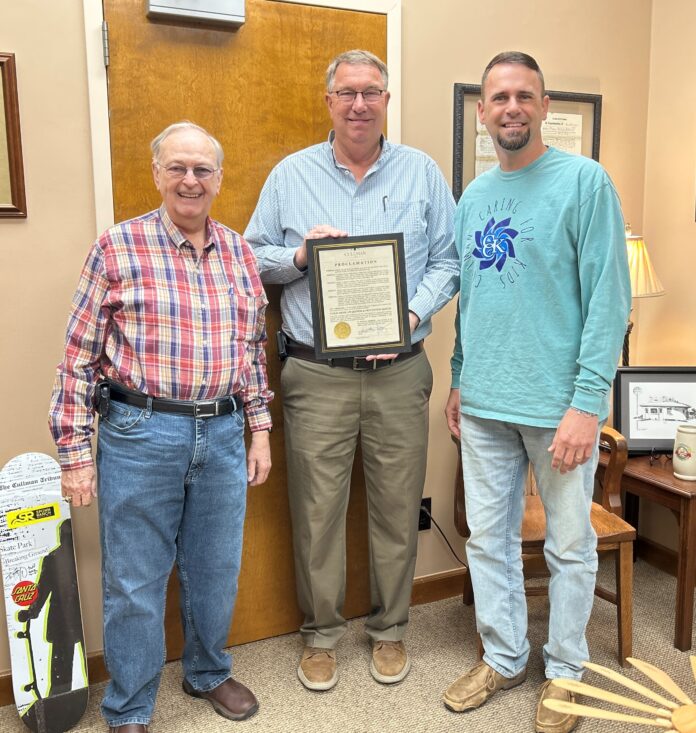CULLMAN, Ala. – On Monday, March 25, 2024, Mayor Woody Jacobs proclaimed the month of April Child Abuse Prevention Month (NCAPM) in the city of Cullman. The proclamation was presented to Cullman Caring for Kids (CCK) Executive Director Steven Sutter and Senior Director Javon Daniel. CCK is a local nonprofit with a mission to see that “no child will ever be abused, no child will go to bed hungry, no infants will ever be shaken in anger and the cycle of abuse will be stopped.”
NCAPM is an opportunity to educate others and raise awareness about the importance of preventing child maltreatment. This initiative is rooted in communities working together to serve children and their families in meaningful, impactful ways that provide families with the support they need, especially during challenging times.
“This is a very important cause that we try to bring awareness to each year,” said Jacobs. “We appreciate the work that Cullman Caring for Kids and other local agencies do to bring awareness to the issue of child abuse and to help victims and families.”
The Alabama Department of Public Health lists child abuse and neglect as the No. 9 health concern. Rates have been increasing in recent years. In 2021, there were 26,116 reported cases of child abuse or neglect investigated in Alabama, and many cases that are never reported. To make child abuse less likely to occur, we must invest in our community and our families. Each year, CCK, Brooks’ Place, Cullman County CASA, DHR and other local agencies work to educate others about child maltreatment and raise awareness about the impact child abuse has on children and society.
Providing information about best practices that are known to build parental capacity through protective factors is key to helping families become more resilient. Protective factors are conditions or attributes that mitigate or eliminate maltreatment risk factors and can increase the health and well-being of children and families. They give parents the tools they need to parent effectively, even under stress. Protective factors include nurturing and attachment, knowledge of parenting and child youth development, parental resilience, social connections and concrete supports for parents.
“All children deserve to grow up in safe environments with people who love them and care for them,” said Jacobs. “It is my hope that by increasing awareness of child abuse and sharing ways everyone can become involved in preventing it, we will one day see child abuse rates decline in our community and throughout the world.”
WHAT IS CHILD ABUSE AND NEGLECT?
Alabama law defines child abuse and neglect (also referred to as child maltreatment) as follows:
- Child abuse: “…harm or threatened harm to a child’s health or welfare which can occur through nonaccidental physical or mental injury, sexual abuse or attempted sexual abuse, sexual exploitation or attempted sexual exploitation.”
- Child neglect: “…negligent treatment or maltreatment of a child, including the failure to provide adequate food, medical treatment, clothing or shelter.”
The Child Abuse Prevention and Treatment Act (CAPTA) defines child abuse and neglect as “any recent act or failure to act on the part of the parent or caretaker which results in death, serious physical or emotional harm, sexual abuse or exploitation … or an act or failure to act which presents an imminent risk of serious harm.” More specifically, definitions include (from childwelfare.gov):
- Physical abuse: Nonaccidental physical injury to a child caused by a parent or caregiver including punching, beating, kicking, biting, shaking, throwing, stabbing, choking, hitting, burning or otherwise causing physical harm
- Neglect: Failure of a parent or caregiver to provide for basic needs such as food or shelter, medical treatment, education needs or emotional needs.
- Sexual abuse: Activities by a parent or caregiver such as fondling a child’s genitals, penetration, incest, rape, sodomy, indecent exposure or exploitation through prostitution or production of pornographic materials.
- Emotional (psychological) abuse: Pattern of behavior that impairs a child’s emotional development or sense of self-worth. This can include constant criticism, threats, rejection or the withholding of love, support or guidance.
- Abandonment: A child is considered abandoned when the parent’s identity or whereabouts are unknown, the child has been left alone in circumstances where the child suffers serious harm, the child has been deserted with no regard for his or her health or safety, or the parent has failed to maintain contact with the child or provide reasonable support for a specified period of time.
- Parental substance use: Related circumstances include exposing a child to harm prenatally due to the mother’s use of legal or illegal drugs or other substances; manufacturing methamphetamine in the presence of a child; selling, distributing or giving illegal drugs or alcohol to a child; or using a controlled substance that impairs the caregiver’s ability to adequately care for the child.
- Human trafficking: Recruiting, harboring, transporting, providing, or obtaining someone for a commercial sex act such as prostitution, pornography or stripping
HOW MANY CHILDREN ARE MALTREATED EACH YEAR?
The Children’s Bureau (CB) – an Office of the Administration for Children & Families (ACYF) administered by the U.S. Department of Health and Human Services (HHS) – reports that in 2022 3,096,011 children received either an investigation response or alternative response at a rate of 42.4 children per 1,000 in the population. In the U.S. (including Washington D.C. and Puerto Rico), there were 558,899 victims of child abuse and neglect (7.7 victims per 1,000 children). An estimated 1,990 children died from abuse and neglect in 2022; 2.73 per 100,000 children.
Of those 5580899 child abuse and neglect cases:
- 74.3% involved neglect
- 17.0% involved physical abuse
- 10.6% involved sexual abuse
- 6.8% involved psychological maltreatment
Data also shows:
- Children younger than 1 have the highest rate of victimization at 22.2 per 1,000 children of the same age nationally
- The victimization rate of girls is 8.2 per 1,000 girls, which is higher than boys (7.1 per 1,000 boys)
- American-Indian or Alaska Native children have the highest rate of victimization at 14.3 per 1,000 children of the same race or ethnicity; black or African-American children have the second highest rate at 12.1 per 1,000 children of the same race or ethnicity
HOW DO I KNOW IF A CHILD IS BEING MALTREATED?
Signs that a child may be being abused or neglected may include:
General maltreatment:
- Exhibiting a sudden change in behavior or school performance
- Having difficulty concentrating not attributed to physical or psychological causes
- Lacking adult supervision
- Being watchful, as though preparing for something bad to happen
- Being overly compliant, passive or withdrawn
- Seeming reluctant to be around a particular person
- Coming to school or other activities early, staying late and not wanting to go home
- Telling someone he/she is being maltreated
Physical abuse:
- Having unexplained injuries (burns, bites, bruises, broken bones, black eyes, etc.)
- Having fading bruises or other noticeable marks after an absence from school
- Seeming scared, anxious, depressed, withdrawn or aggressive
- Seeming frightened of parents and protesting or crying when it’s time to go home
- Showing changes in eating and sleeping habits
- Abusing animals or pets
- Shrinking at the approach of adults
- Reporting injuries by a parent or other adult caregiver
Neglect:
- Being frequently absent from school
- Begging or stealing food or money
- Being consistently dirty or having severe body odor
- Not receiving help for known physical or medical problems or lacking medical care (e.g., immunizations, dental care, glasses, etc.)
- Lacking sufficient clothing for the weather
- Abusing alcohol or other drugs
- Stating that there is no one at home to provide care
Sexual abuse:
- Having difficulty walking or sitting
- Experiencing bleeding, bruising, or swelling in the genitals
- Suddenly refusing to go to school
- Reporting nighttime bedwetting
- Experiencing a sudden change in appetite
- Demonstrating bizarre, sophisticated or unusual sexual knowledge or behavior
- Becoming pregnant or contracting a sexually transmitted disease (especially if under 14)
- Running away from home
- Attaching very quickly to strangers or new adults
- Reporting sexual abuse by a parent or another adult caregiver
Emotional abuse:
- Showing extremes in behavior (overly compliant or demanding, extremely passive or aggressive, etc.)
- Being either inappropriately adult (parenting other children, etc.) or inappropriately infantile (rocking, head-banging, etc.)
- Exhibiting delays in physical or emotional development
- Showing signs of depression or suicidal thoughts
- Reporting an inability to develop emotional bonds with others
Signs that a parent or caregiver may be abusive or neglectful include:
- Showing little concern for, or indifference toward, the child and refusing to consider offers of help for the child’s problems
- Denying the existence of problems at school or home, or blaming the child for those problems
- Asking teachers or caregivers to use harsh physical discipline if the child misbehaves.
- Seeing the child as entirely bad, worthless or burdensome
- Demanding a level of physical or academic performance the child cannot achieve
- Looking primarily to the child for care, attention and satisfaction of emotional needs
- Constantly blaming, belittling, or berating the child
- Overtly rejecting the child
- Seeming apathetic or depressed
- Behaving irrationally or in a bizarre manner
- Abusing alcohol or other drugs
- Being unduly protective of the child or severely limiting the child’s contact with other children, especially if the child is of the opposite sex
- Being secretive and isolated
- Being jealous or controlling with family members
HOW DO I REPORT SUSPECTED CHILD ABUSE OR NEGLECT?
If you suspect a child is being harmed, reporting your suspicions may protect the child and get help for the family. If you suspect a child is being maltreated, contact your local Department of Human Resources or law enforcement agency. In Cullman County those numbers include:
- Cullman County DHR (256-737-5300)
- Cullman Police Department (256-734-1434)
- Cullman County Sheriff’s Office (256-775-4700)
- Hanceville Police Department (256-352-9811)
WHAT CAN BE DONE TO PREVENT CHILD MALTREATMENT?
The Childhelp Alabama Hotline – 1-800-4ACHILD (1-800-422.4453) – is staffed with professional crisis counselors with access to a huge database of emergency, social service, and support resources. They are available 24 hours a day, seven days a week, to children who are confused, parents who are in despair and need help, and adults (including mandatory reports) who are uncertain about the next best step when faced with questions related to child maltreatment. All calls to this hotline are anonymous.
Supportive communities can help build strong families which, in turn, can help lower the risk of child abuse and neglect. In Cullman we help build strong families by providing or supporting:
- Parks and recreational facilities that are safe, accessible, and inviting places for families
- Resources to help families in need access food, jobs, medical care and other resources
- Early education programs that are easily accessible and welcoming
- Safe, affordable housing available to all families
- Clean air and water
And the main thing that everyone can do – and the true purpose of Child Abuse Prevention and Awareness Month – is to help parents obtain the knowledge, skills and resources they need to properly love and care for their children.
“Cullman is fortunate to have people and organizations who help children and families dealing with abuse and neglect,” said Jacobs. “We appreciate them all!”
For more information on these agencies, you can visit them online at:
- Cullman Caring for Kids: www.cullmancaringforkids.com
- Child Advocacy Center (Brooks’ Place): www.cullmancac.com
- Cullman County CASA: www.cullmancaringforkids.com/casa.html
- Cullman County DHR: dhr.alabama.gov
For more information about National Child Abuse Awareness Month visit www.childwelfare.com/preventionmonth.




















